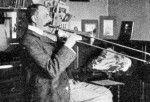 Thomas G. Everett’s contributions to the bass trombone and music have been vast and unique. It almost reads as though it were three different lives. First, there is Tom Everett the foremost scholar of the bass trombone: one of the key founders and first president of the International Trombone Association, author of the ‘Annotated Guide to Bass Trombone Literature’, with more than thirty-five published articles and interviews. Second, there is Tom Everett the conductor: who served as the Director of Bands at Harvard University, founded the Harvard Jazz Bands & Wind Ensemble, and conducted on J. J. Johnson’s recording ‘Brass Orchestra’. The third Tom Everett is the most active bass trombone recitalist of his generation, having performed at Carnegie Hall and being involved with bringing more than 30 pieces into the bass trombone repertoire, all while performing with the likes of Dizzy Gillespie, the Bolshoi Ballet and Ray Charles. Thomas Everett represents an unbridled passion for music as seen through the prism of the bass trombone. He is a trailblazing pioneer and a visionary. We are honored to have Everett respond for our sixth edition of ‘Seven Positions’.
Thomas G. Everett’s contributions to the bass trombone and music have been vast and unique. It almost reads as though it were three different lives. First, there is Tom Everett the foremost scholar of the bass trombone: one of the key founders and first president of the International Trombone Association, author of the ‘Annotated Guide to Bass Trombone Literature’, with more than thirty-five published articles and interviews. Second, there is Tom Everett the conductor: who served as the Director of Bands at Harvard University, founded the Harvard Jazz Bands & Wind Ensemble, and conducted on J. J. Johnson’s recording ‘Brass Orchestra’. The third Tom Everett is the most active bass trombone recitalist of his generation, having performed at Carnegie Hall and being involved with bringing more than 30 pieces into the bass trombone repertoire, all while performing with the likes of Dizzy Gillespie, the Bolshoi Ballet and Ray Charles. Thomas Everett represents an unbridled passion for music as seen through the prism of the bass trombone. He is a trailblazing pioneer and a visionary. We are honored to have Everett respond for our sixth edition of ‘Seven Positions’.
1st Position
What do you look for in an instrument?
Instrument choices are of course guided by the player’s personal concepts, priorities and demands for the ensembles and styles they perform. In general, I would look for an instrument that was comfortable to play, both in the physical feel (balance and left hand comfort) and ease of playing (sound production/response). The single most important concern is the sound/tone quality produced on the instrument. Was the tone centered/focused, yet flexibly? My personal bass trombone tone concept and playing situations led me to choose an instruments that produced a dark/mellow sound that would blend well in section playing. Next is the tuning (overtone series, alternate positions) and consistency of response throughout all registers.
2nd Position
How do you conceive of describe, or visualize an ideal tone quality?
Originally drawn to the bass trombone because of an attraction to, and desire to emulate, the sound of several performers (primarily George Roberts), I always had a clear, aural reference and concept for my desired sound.
3rd Position
What is your secret to a good legato?
Simply stated, the challenge of legato is the coordination of air, tongue,and slide. Air – maintain support throughout the slur; Tongue -use of a “soft” syllable articulation (depending on register, a “doo”,”loo, or “dah” are starting places); Slide – wait until the last moment to move the slide rapidly, but smoothly, to the next position. Singing is always the model. Playing the euphonium (or some other valved brass bass instrument) often aids the body and mind to experience legato.
4th Position
What helps you achieve musical expression?
Musical expression is of course a very personal sensitivity and pursuit.
Musical maturity, insights into musical meaning and concepts of communicating with listeners is usually developed outside the practice room. Expression is not directly related to technique or fostered in a vacuum. Schedule time to: listen to recordings and live performances by major ensembles and significant artists (especially singers, violinists, cellists, pianists, guitarists); attend dramatic and dance performances;
visit a museum, read a poem. In short, one must expand both their artistic boundaries, and creative thought. Devote practice time to analyzing and understanding the form and shapes a particular work; research the composer and background history of the composition; sing the music (participation in a quality choir experience is encouraged).Know the music well enough NOT to be glued to the printed page. Investigate the entire composition (not just the trombone part). Study the accompanying piano part, or full score – noting phrases, patterns, harmony shapes, rhythmic interactions, etc. What was the composers intent? Lastly, aspire to move beyond the purely physical/technical demands of the music in order to be able to focus/visualize the desired flow, sound and “feel” of your performance.
5th Position
Name two inspirations. One musical and one non-musical.
Several individuals have had a significant influence impact upon my musical and personal life. Composer Warren Benson and my father, Walter Everett, continue to be inspirations in most all that I do. (The question requested the name of only ONE musical inspiration, but trombone teacher Emory Remington, conductor/educator Frank Battisti, and jazz pianist Bill Evans have also shaped my musical ear and priorities).
6th Position
Please comment on bass trombone solo literature.
The question of what constitutes “great” art is a challenging and fascinating topic. This would be a terrific topic for on going discussions…maybe on an ITA blog or in the ITA Journal? The evaluation of a work from the bass trombone repertoire should adhere to the same standards and criteria as solo literature for tenor trombone, clarinet, violin.
That said, my recital programing has emphasized repertoire conceived for (what I perceive to be) the unique timbre of the bass trombone.
7th Position
What would you like to see pursued regarding trombone research?
The amount, and diversity of scholarly research within the brass field over the last twenty-five years have been remarkable. Suggestions for future research/papers: Detailed comparison/analysis of specific composition(s) recorded by several trombone artists; Detailed research investigation into the life, influences, time period and musical colleagues of lesser known, yet influential improvising, jazz and commercial trombonists; Interviews with composers of frequently programed trombone literature, offering background, interpretation, and performance suggestions.
T1 Best trombone playing you’ve ever heard?
I’ve been fortunate to have heard many remarkable trombone performances. A couple of live performances that stand out would include my first time hearing Vinko Globakar’s, (as well as Stuart Dempster’s), performance of Luciano Berio’s “Sequenza”); Bill Pierce’s opening of his first performance at a late 70’s International Trombone Workshop (now the ITF); hearing Phil Wilson perform lead trombone and as a soloist with the mid 60’s Woody Herman Band; an evening of concertos performed by Carstan Svanberg’s and orchestra (ITW); the sound and phrasing of George Roberts
T2 Best playing you’ve ever done?
My most satisfying (and single moment of perfection) occurred as a member of a ITW faculty trombone choir (twenty-one players) backing up guest soloist Urbie Green. Tom Streeter and I shared a bass trombone part. At the end of one ballad, we played a soft low C (below the bass clef) on the sustained final C chord. The chord was absolutely perfect. As Tom and I looked down the ensemble to acknowledge the bass trombonists that had simultaneously produced the C an octave higher, we realized that it was George Roberts and Lewis Van Haney! Doesn’t get any better than that.
davidbrubeck.com c 2013 David William Brubeck All Rights Reserved.
Interested in more “Seven Positions†tm Interviews?
Charlie Vernon
James Markey
Chris Brubeck
Doug Yeo
Jeremy Morrow
Tom Everett
Gerry Pagano
Ben van Dijk
Randall Hawes
Denson Paul Pollard
Thomas Matta
Fred Sturm
Bill Reichenbach
Massimo Pirone
Erik Van Lier
Jennifer Wharton
Matyas Veer
Stefan Schulz
c. 2013/2014 David William Brubeck All Rights Reserved davidbrubeck.com


